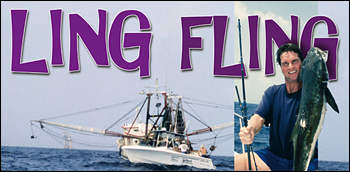
Ling, cobia or lemonfish, by any name
they're world-class fighters.
By Chester Moore, Jr.
To an untrained eye, the buoy in the distance might have seemed like a mere dot on the rolling, blue landscape of the Gulf of Mexico. But to Troy Coleman of Central Flyway Outfitters the buoy meant the possibility of salvaging a difficult day offshore.
Ed Welch of Houston had won a Texas Fish & GameTM Trophy QuestTM with Coleman during the previous year, but bad weather and conflicting schedules made actually getting the trip under way perplexing. And when they finally got a chance to get offshore, Mother Nature made things difficult by churning up the seas and turning the sun up to meltdown level. It was hot, rough and windy.
The catch of king mackerel and a few snapper was good considering the circumstances, but it could have been better. Coleman was hoping that what might lurk under the buoy would be enough to make the trip truly worthwhile.
"Let's see if there are any ling around this buoy," Coleman said as he slowed his boat to a crawl.
At first it looked as if he had drawn a blank, but after revving the engine and churning the water a little, a brown mass began to move up through the clear, blue abyss.
"There's something down there. It might be ling," Welch said.
"There ain't no doubt about it," Coleman said. "That is a ling. Get the lines in the water and catch one of them."
 It wasn't long before everyone in the boat, myself included, had a rod in his hand and was trying to hook up with one of the dozen-plus ling. The small fish were eager to bite, but the big fish didn't seem to appreciate our offering of cut Spanish sardine. It wasn't long before everyone in the boat, myself included, had a rod in his hand and was trying to hook up with one of the dozen-plus ling. The small fish were eager to bite, but the big fish didn't seem to appreciate our offering of cut Spanish sardine.
That is, until Welch put his bait right in front of a 40-pound class ling that stayed about 5 feet below the water's surface. With a simple opening of its large mouth, the big fish inhaled the sardine and began peeling the drag on Welch's reel as if it meant business.
"Make sure your drag is right," Coleman warned. "If the fish doesn't dive down by the buoy, we're in open water. We can get him in."
He was concerned because Welch was using light tackle for such a big fish, but as luck would have it, the fish opted to stay near the water's surface and move away from the buoy. Welch reeled and reeled and the fish would pull more line. The other ling in the bunch kept following the big boy around as if to say "so long sucker. You shouldn't have fallen for that old trick."
Welch finally landed the fish after a skillful gaffing job by Coleman's partner, Will Beaty, and everyone in the boat was elated. After a round of "hoorahs" and high fives, the fish was put on ice and we headed toward shore. That big ling made the trip.
And that's what ling do best. They make trips.
Ling aren't usually the primary species sought on an offshore adventure in Texas, but they're always a welcomed addition to a catch. Ling are strong, stubborn fighters, a challenge to hook and tops on the table.
Locating ling is no problem. They're suckers for structure in Gulf waters and can often be found hanging around oil platforms, stand pipes, jetties and buoys. They're also extremely curious and seem to be interested in taking a look at whoever is visiting their hangout.
One of the best tactics for locating ling around structure is to rev up the motors like Coleman did or take a paddle and pound the water's surface to get the attention of the fish. The first time I saw this done I thought the guy doing it was crazy. I had always been taught to be quiet in the boat and to avoid spooking the fish. But when I saw a huge ling rise up to the surface I was convinced that the technique was for real. Ling are just plain different than any other fish.
They also bite different than other fish. A 50-pound ling sports a mouth that could probably inhale a small child, yet the same ling can become extremely hard to put a hook into.
I've always wondered why they are so finicky and have asked just about every expert there is. All of them have told me that ling are line shy, and now I believe it.
continued
page 1 / page 2
| 




